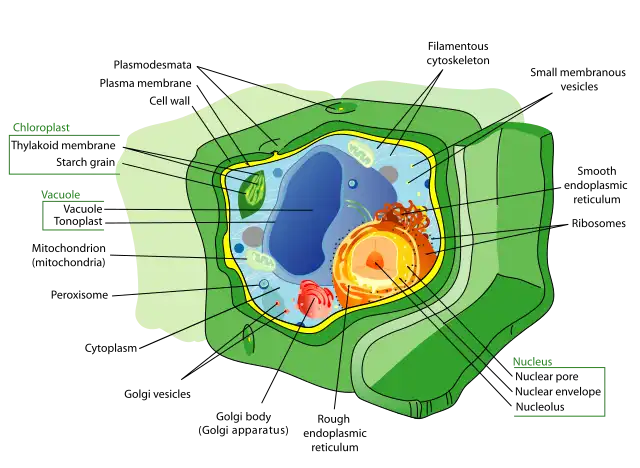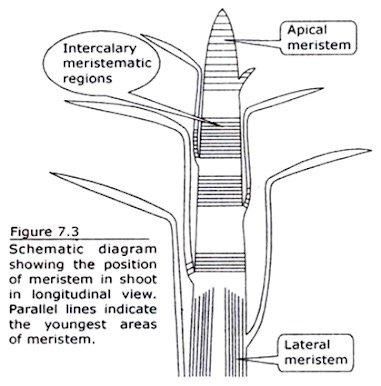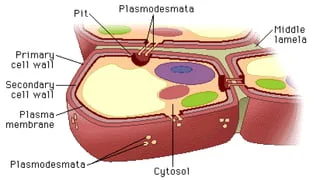GROUPS OF CELL WALL
- Fungal cell wall:- The fungal cell wall is generally composed of chitin, a polymer of N-acetylgucosamine (NAG) unit.
- Algal cell wall:- The algal cell wall is made up of cellulose, galactans nad mnnans and minerals like calcium carbonate.
- Plant cell wall:- The plant cell wall is chiefly composed of the insoluble polysaccharides (cellulose). Certain other compounds, such as hemicellulose, pectin and proteins are also present in the cell wall.

REGIONS OF PLANT CELL WALL
- The cell wall of plants consists of two regions:-
- Primary wall:– A young plant cell forms a single layer of wall material. This layer is known as the primary cell wall. The primary wall is thin, elastic and capable of expansion in a growing cell. It grows by addition of more wall material within the existing one. Meristematic and parenchymatous cells have primary cell wall only.
- Secondary wall:- In mature cell, more layers of wall material are added internal to the primary wall. These layers are called the secondary cell wall. Addition of secondary wall brings about thickening of the cell wall. Thickening of cell wall occurs particularly in cells that form the harder woody parts such a lignified and suberised cell wall.
Note:- Middle lamella:- Adjacent cells in a plant tissue are held together by a thin, sticky, amorphous layer of cementing material. This layer is called the middle lamella. Middle lamella is chiefly made up of calcium and magnesium pectate. In ripening fruits, the pectate compounds solubilize to a jelly-like material, making the fruit soft. The cell wall and middle lamella may be traversed by plasmodesmata which connect the cytoplasm or neighbouring plant cells

FUNCTIONS OF CELL WALL
The cell wall serves many functions:-
- It maintains shape of the cells.
- It protects the cells from mechanical injury.
- it wards off the attacks of pathogens like viruses, bacteria,fungi etc..
- It allows the materials to pass in and out of the cell.
- It helps in cell-to-cell interaction and provides barrier to undesirable macromolecules.
Pits:- The cell wall is not uniform in thickness throughout; because at certain places secondary wall is not laid down. Such unthickened areas are called pits. Pits of the adjacent cells generally lie opposite to each other and form pit pairs.
Pits are of two types:-
(i) Simple pit:- Pit cavity is uniform in diameter.
(ii) Bordered pit:- Pit cavity is flask-shaped, as in tracheids.
Plasmodesmats:- It forms the living component in the dead wall. A number of plasmodesmata or cytoplasmic strands are present in pit through which the cytoplasm of one cell is in contact with other. These are lined by plasma membrane and contains a fine tubule called desmotubule. Endoplasmic reticulum plays a role in origin of plasmodesmata. These form the symplastic system between two cells.

FUNFACTS
Composition Diversity: Cell walls are not uniform across all organisms; they vary greatly in composition and structure. For example, plant cell walls are primarily composed of cellulose, while fungal cell walls contain chitin, and bacterial cell walls consist of peptidoglycan.
Strength and Support: One of the primary functions of the cell wall is to provide strength and support to the cell, especially in plants. The cell wall helps maintain the cell’s shape, prevents it from bursting due to osmotic pressure, and provides structural support for the entire plant.
Unique Properties: The cell wall possesses unique properties that contribute to its functionality. For example, plant cell walls have a secondary cell wall layer that contains lignin, a complex polymer that adds rigidity and waterproofing properties to the cell wall, allowing plants to grow upright and resist gravity.
Role in Defense: In addition to providing structural support, cell walls play a crucial role in defense against pathogens and environmental stressors. Some plant cell walls contain antimicrobial compounds and specialized proteins that help protect the plant from microbial infections and herbivore attacks.
Cell-to-Cell Communication: Cell walls also facilitate communication between neighboring cells. Plasmodesmata, small channels that traverse the cell wall, allow for the exchange of molecules and information between adjacent plant cells, enabling coordinated growth and development.
Dynamic Nature: Contrary to popular belief, cell walls are not static structures; they can be modified and remodeled in response to developmental cues and environmental stimuli. For example, during plant growth and tissue differentiation, cell walls undergo changes in composition and thickness to accommodate the changing needs of the cell.
Biotechnological Applications: The unique properties of cell walls have inspired various biotechnological applications. Researchers are exploring ways to harness the strength and resilience of cell walls for the development of sustainable materials, such as biofuels, bioplastics, and nanocomposites.
Historical Significance: The study of cell walls has a rich historical legacy in the field of biology. In the 19th century, scientists such as Matthias Schleiden and Theodor Schwann proposed the cell theory, which highlighted the importance of cell walls as defining features of plant and fungal cells.
Evolutionary Adaptations: The presence of cell walls in certain organisms, such as plants, algae, fungi, and bacteria, represents an evolutionary adaptation to diverse ecological niches. Cell walls provide these organisms with a competitive advantage in various environments, allowing them to thrive and diversify over time.
Cultural Significance: Cell walls have cultural significance beyond their biological functions. For example, plant cell walls have been used historically for purposes such as building materials, papermaking, and dietary fiber in human nutrition, highlighting their importance in human culture and society.
- The cell wall is a rigid outer layer that surrounds the cell membrane of certain organisms, providing structural support and protection. It is found in plants, algae, fungi, some protists, and certain prokaryotes such as bacteria.
- The composition of the cell wall varies depending on the organism. In plants, the cell wall is primarily composed of cellulose, hemicellulose, and pectin. Fungal cell walls contain chitin, glucans, and proteins, while bacterial cell walls are made of peptidoglycan or other polymers.
- In plants, the cell wall provides structural support, helps maintain cell shape, prevents excessive water uptake, and protects against pathogens and environmental stresses. It also plays a role in regulating cell growth and development.
- The cell wall determines the rigidity and flexibility of plant cells, influencing processes such as cell expansion, tissue differentiation, and organ formation. By providing mechanical support, the cell wall allows plants to grow upright and withstand gravitational forces.
- Plasmodesmata are microscopic channels that traverse the cell wall, connecting the cytoplasm of adjacent plant cells. These channels facilitate the exchange of water, nutrients, and signaling molecules between cells, enabling coordinated growth and communication.
- Plant cell walls contain structural components such as lignin and specialized proteins that help defend against pathogens and herbivores. Lignin adds strength and impermeability to the cell wall, while antimicrobial proteins disrupt the growth of pathogens.
- Yes, researchers have explored various biotechnological applications of cell wall modification. Techniques such as genetic engineering and enzymatic treatments can alter the composition and properties of cell walls, potentially improving crop yields, biofuel production, and the development of sustainable materials.